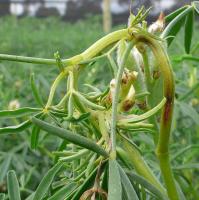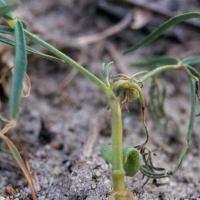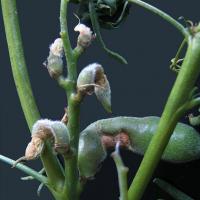Diagnosing anthracnose in narrow-leafed lupins
Anthracnose is a fungal disease (Colletotrichum lupini) that is usually only serious in high rainfall areas of the northern agricultural region. All lupin species are affected, but albus lupin, yellow lupin and sandplain blue lupin are more susceptible than narrow-leafed lupin.
What to look for
- Patches of plants with bent and twisted stems.
- Infected plants originating from infected seed distributed evenly throughout the paddock provide centres for further spread.
- Disease can spread from infected sandplain lupins adjacent to, or in the crop.
Paddock
- Seed-infected seedlings can develop lesions on the cotyledons, leaf petioles or stems and may die.
- The most distinctive symptom is the bending and twisting of stems with a lesion in the crook of the bend.
- Stem lesions are usually dark-brown and up to 2cm long. A pale pinkish or sometimes orange spore mass develops within the lesions. The stem is often girdled by lesions or is so weakened that it breaks.
- The main stem, lateral branches and leaf petioles can be affected.
- Pods are often twisted and distorted with lesions containing characteristic pink/orange spores.
- Infected seeds can be malformed and have brown lesions, fungal mycelium or pink spores on the seed surface. Seeds can also be infected without showing symptoms.
Plant
What else could it be
| Condition | Similarities | Differences |
|---|---|---|
| Diagnosing frost in narrow-leafed lupins | Similar shepherd’s crook symptoms on stems and upper foliage death | Wilted plants that lack lesions with spores in the bend of the crook. |
| Diagnosing bean yellow mosaic virus - early symptoms in narrow-leafed lupins | Similar shepherd’s crook symptoms on stems and upper foliage death | No lesions or spores in the bend of the crook. |
Where did it come from?

Contaminated seed

Wet or humid conditions

Susceptible varieties
- Infection comes into a crop from two main sources:
- Seedlings growing from infected seed can develop lesions on the cotyledons, leaf, petioles or stems. Spores from these lesions are spread through the crop by rain-splash.
- Spores spread from nearby infected lupin, such as sandplain lupin. Most spores spread only a few metres, but some travel further when splashed droplets are blown as aerosols by strong winds. Spread of more than 100m has been recorded. Spores can be spread even longer distances by farm machinery, animals and insects.
- Lupin stubble is not a major source of infection.
- The level of infected seed sown, climatic conditions, susceptibility of variety sown and proximity of other infected lupins all contribute to anthracnose risk.
- Spores are splashed from infected plants, therefore heavy rainfall facilitates disease spread.
- Warmer temperatures increase the rate of symptom development and spore production.
- Flower heads and pods of all varieties (including resistant varieties) are more susceptible to infection than stems and lateral branches.
- Pod set can be substantially reduced by infection on flower heads and pods. Consequently, yield loss will be greatest where infection within a crop or adjacent blue lupin becomes severe before flowering.
Management strategies

Resistant varieties

Clean seed

Seed dressing fungicide

Weed control

Spraying foliar
- Resistant varieties are available; these should be used in higher risk environments.
- Seed can be tested for the presence and quantity of anthracnose infection.
- Use of clean seed is ideal but in some circumstances (for example, resistant varieties or lower rainfall area) low levels of seed infection can be tolerated. Use seed from crops with no visible anthracnose infection.
- Thiram based seed dressing fungicide will reduce disease transmission from infected seed.
- Blue lupins are a common source of inoculum, if possible blue lupins should be destroyed or separation from susceptible varieties maintained.
- In high disease situations, registered foliar sprays applied at early podding on main stems and first order branches can be used to reduce yield loss.
How can it be monitored?
- Test seed for disease infection.
Where to go for expert help
Page last updated: Wednesday, 26 April 2017 - 2:19pm




